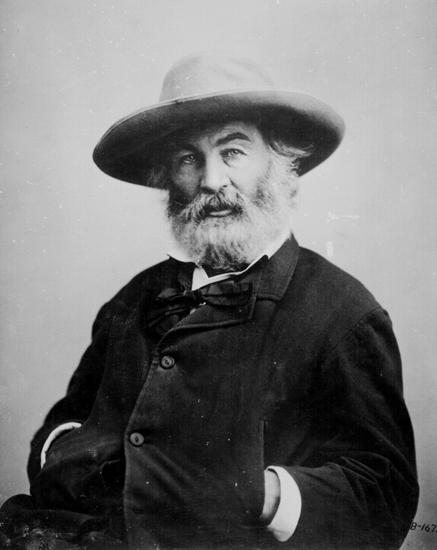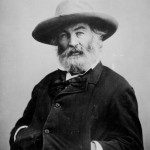As you leave the Dupont Circle Metro station’s north exit, you will see words carved into the granite walls — lines from a poem by Walt Whitman, called “The Wound Dresser.” Since it’s hard to get the whole inscription when you are riding the escalator, here it is:
Thus in silence in dreams’ projections,
Returning, resuming, I thread my way through the hospitals;
The hurt and the wounded I pacify with soothing hand;
I sit by the restless all the dark night — some are so young,
Some suffer so much — I recall the experience sweet and sad.
This was a subject Walt Whitman knew a lot about, since he served as a volunteer nurse during the Civil War. Already known as a journalist and poet, he first got involved after the bloody Battle of Fredericksburg in 1862, where he went to take care of his brother who had been wounded in battle. There he met another impressive volunteer nurse, Clara Barton, with whom he would cross paths again in Washington. When Whitman arrived in the District to help out as a medical volunteer, the city’s public buildings were turned into crowded way stations for wounded soldiers. There were not enough doctors, and no formal nursing profession, so the military had to rely on recruits and volunteers. Even with that, doctors could not deal with the types of wounds inflicted by the advanced bullets and weapons of the war. The quickest solution to treat an infected limb — and save the soldier’s life — was to amputate. Meanwhile, the wounded were crowded into any shelters available, waiting for the meager medical help to arrive.
One of the most haunting passages in Whitman’s journal about his experiences during the war was his account of the makeshift hospital at the Old Patent Office in Washington. This building, recently restored to its original grandeur and serving as the National Portrait Gallery and Museum of American Art, made for a bizarre hospital ward. The maze of long narrow galleries was originally created to hold glass display cases, which held wood and metal models of inventions submitted for patents. Wounded soldiers, sometimes as many as 800, were laid on cots arranged alongside the glass cases, creating a path so inspectors and inventors could still get through the maze to view and judge the models, stepping over the soldiers as they moved along. This was one of many hospitals where Whitman volunteered during the war, bringing food, paper and pens for the men and sometimes just staying on so a wounded soldier would not have to die alone.
Out of these terrible experiences came some good. The war encouraged many advances in medical science. Volunteer nurse Clara Barton went on to found the American Red Cross, an organization that we rely in times of national emergencies and disasters. Meanwhile, Walt Whitman, who continued to write poetry, supported himself with a job at the Department of the Interior. Ironically, when Secretary of the Interior James Harlan discovered that Whitman was the author of “Leaves of Grass,” he fired him, citing the poems as “damaging to the morals of men.” By that time, though, Whitman was revered as a poet and supporters rallied to his cause, soon securing him another government job.
Whitman’s war experiences earned him the title “the good gray poet,” and his poems about the Civil War are forever burned into our collective memory. There are many, among them “O Captain! My Captain!”, “When Lilacs Last in the Dooryard Bloom’d” and, of course, “The Wound Dresser.” And while his words carved on the subway’s wall describe the horrors of war, they also tell about human compassion, which will always be our saving grace.
- Walt Whitman





